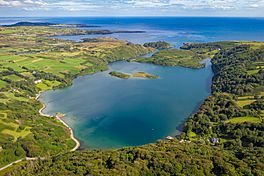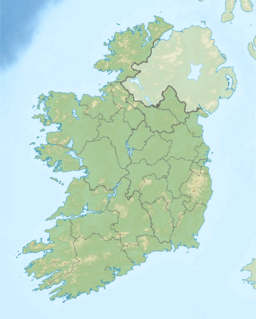Lough Hyne facts for kids
Quick facts for kids Lough Hyne |
|
|---|---|

Aerial view of Lough Hyne from July 2019
|
|
| Location | Carbery West, County Cork |
| Coordinates | 51°30′10″N 9°18′10″W / 51.50278°N 9.30278°W |
| Type | Sea lough |
| Native name | Loch Oighinn Error {{native name checker}}: parameter value is malformed (help) |
| Etymology | Irish: "cauldron lake" |
| Primary inflows | Barloge Creek, Celtic Sea |
| Primary outflows | Barloge Creek, Celtic Sea |
| Catchment area | 2.89 km2 (1.12 sq mi) |
| Basin countries | Ireland |
| Surface area | 0.6 km2 (0.23 sq mi) |
| Max. depth | 50 m (160 ft) |
| Residence time | 9 years |
| Salinity | 34.06 ± 0.543 ‰ |
| Surface elevation | Sea level |
| Islands | 1 (Castle Island) |
Lough Hyne (in Irish: Loch Oighinn) is a special kind of lake in West Cork, Ireland. It's about 5 km southwest of Skibbereen. This lake is connected to the sea and is full of saltwater.
In 1981, Lough Hyne became Ireland's very first Marine Nature Reserve. This means it's a protected area for sea life.
Contents
What Makes Lough Hyne Special?
Thousands of years ago, around 2000 BC, Lough Hyne was a freshwater lake. But then, sea levels rose. Ocean water flowed in, turning the lake salty.
Today, ocean tidal currents bring water into the lake. This water rushes in from the Atlantic through a narrow passage called Barloge Creek. The area between the creek and the lake is known as "The Rapids."
A Unique Home for Sea Life
Lough Hyne is quite small, only about 0.8 km long and 0.6 km wide. Because of its size and how the water flows, it has a very unusual environment. The seawater here is warm and has lots of oxygen. This makes it a perfect home for a huge variety of plants and animals. Many of these creatures are not found anywhere else in Ireland!
The area around the lake also has many different types of environments. There are cliffs, salt marshes, beaches, and places where the water moves very fast or very slowly. All these different spots help make the area rich in biodiversity (many different kinds of life).
Some of the stone walls around the lake and The Rapids were built a long time ago. They were part of a project to help people during a very difficult time in Ireland, known as the Great Hunger.
Studying Lough Hyne
Scientists have been studying Lough Hyne for a long time. The first scientific record was made in 1886 by Rev. William Spottswood Green. He noted the presence of a purple sea urchin there.
In 1923, Professor Louis Renouf continued the scientific work. He helped make Lough Hyne a place for important biological studies. Since then, scientists have kept studying the lake. It is now one of the most-studied places of its size in the world!
Many laboratories were built near the lake's shores. Here, scientists like Professor Jack Kitching and Dr John Ebling did amazing research about the environment. A book about the history of this research, called 'Lough Hyne: The Marine Researchers - in Pictures', was published in 2011.
Visiting Lough Hyne
Lough Hyne is a popular place for visitors. You can learn more about the lake and why it's so important at the Skibbereen Heritage Centre nearby.
Around the lake, you can find the old ruins of Saint Bridgit's Church. There are also two holy wells, Tobarín Súl and Skour Well, on the side of Knockomagh Hill.
In the middle of the lake is Castle Island. On this island, you can still see the ruins of Cloghan Castle. This was once a strong fortress belonging to the O'Driscoll clan.
If you like walking, there's a nature trail up Knockomagh Hill. From the top, you get amazing views of the lake and the area around it. In the summer, many local people and tourists enjoy kayaking and swimming in Lough Hyne.


